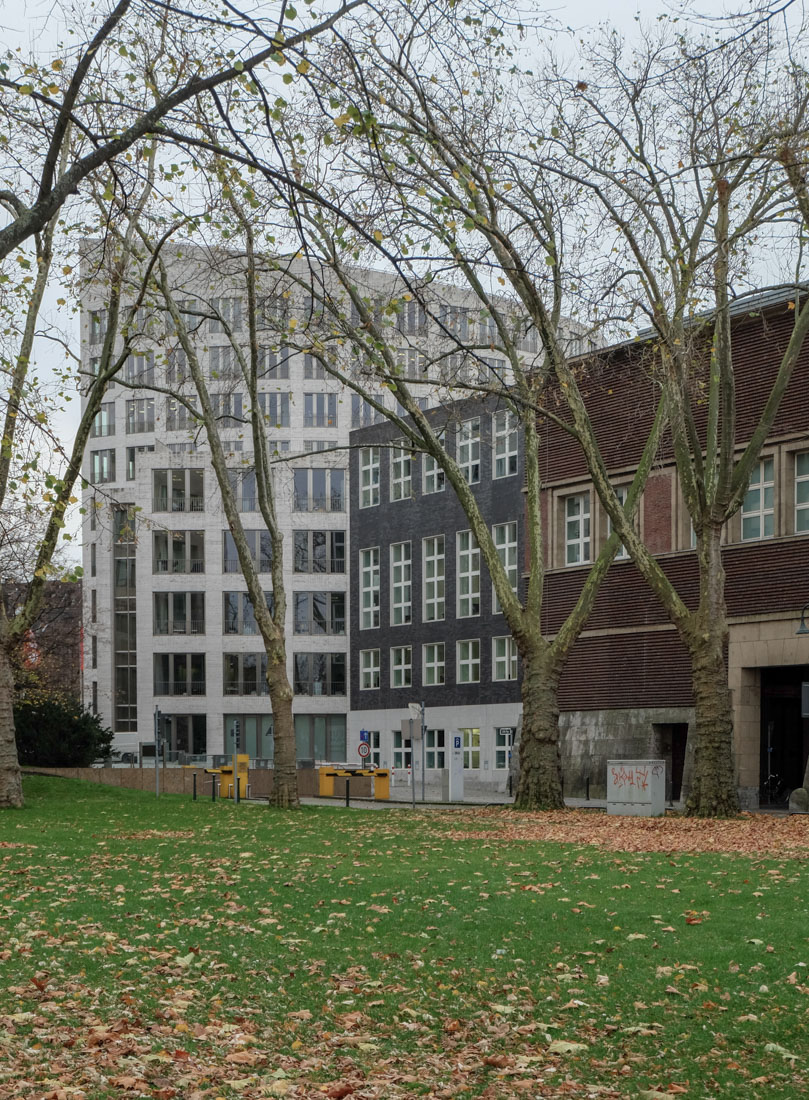 |
 |
 |
 |


Palace of the Arts Duesseldorf
Ehrenhof 4-5, Düsseldorf
1995 - 2001
The "Kunstpalast" Düsseldorf was built between 1995 and 2001 according to a design by Oswald Mathias Ungers.
The refurbishment and expansion project goes back to a winning
competition proposal from the year 1995. Construction had begun in 1998
and was completed in 2001. As part of this construction, the exhibition
rooms in the existing museum have been redesigned. After completion,
the new building and the existing art museum were reopened under the
new name "Museum Kunstpalast". The exhibition space of the historic
museum building was greatly enlarged by the new wing of the building.
In addition, the museum complex is connected to the adjacent corporate
building.
Basically, the design of Oswald Mathias Ungers is divided into two parts. It is a new wing to complement the existing complex, and a detached building built over a semicircular floor plan. The design by Oswald Mathias Ungers fits into the so-called Herrenhof complex by Wilhelm Kreis from the 1920s. With this project the symmetrically constructed court of honor was completed. The three-storey volume by Oswald Mathias Ungers faces the old building. The building adopts the typology of the existing building and transforms it into a new interpretation. The building contains four large exhibition halls with a total of 3,000 square meters. The heart of the building is the central domed hall, which is to be understood as a contemporary counterpart to the entrance hall in the old building. The Art Palace houses the Department of Contemporary Art. On the side to the Rhine, the architectural ensemble is completed by a cylindrical volume. This independent structure relates the strictly orthogonal figure of the court of honor to the disperse urban landscape of the area.
Der Kunstpalast Düsseldorf entstand in den Jahren 1995 bis 2001 nach einem Entwurf von Oswald Mathias Ungers. Sanierungs und Erweiterungsprojekt geht auf einen siegreichen Wettbewerbsvorschlag aus dem Jahr 1995 zurück. Die Bauarbeiten hatten im Jahr 1998 begonnen, und wurden 2001 abgeschlossen. Im Rahmen dieser Baumassnahmen wurden auch die Ausstellungsräume im bestehenden Museum neu gestaltet. Nach der Fertigstellung wurden der neue Bau und das bestehende Kunstmuseum unter dem neue Namen "Museum Kunstpalast" wiedereröffnet. Die Ausstellungsfläche des historischen Museumsgebäude wurde durch den neuen Gebäudeflügel stark vergrössert. Zudem ist der Museumskomplex mit dem angrenzenden Unternehmensgebäude verbunden.
Grundsätzlich gliedert sich der Entwurf von Oswald Mathias Ungers in zwei Teile. Es handelt sich dabei um einen neuen Flügel als Ergänzung zum bestehenden Komplex, und eine losgelöstes Gebäude, welches über einem halbrunden Grundriss errichtet wurde. Der Entwurf von Oswald Mathias Ungers fügt sich in den sogenannten Herrenhof-Komplex von Wilhelm Kreis aus den 1920er Jahren ein. Mit diesem Projet wurde der symmetrisch aufgebaute Ehrenhof komplettiert. Das dreigeschossige Gebäude von Oswald Mathias Ungers steht dem Altbau gegenüber. Das Gebäude übernimmt die Typologie des Bestandes, und transformiert diese in einer neuen Interpretation. Das Gebäude enthält viergrosse Ausstellungssäle mit insgesamt 3'000 Quadratmetern Fläche. Herzstück des Gebäudes ist der zentrale Kuppelsaal, welcher als zeitgenössisches Gegenstück zur Eingangshalle im Altbau zu verstehen ist. Im Kunstpalast befindet sich die Abteilung für zeitgenössische Kunst. Auf der Seite zum Rhein wird das architektonische Ensemple durch ein zylindrisches Bauvolumen abgeschlossen. Dieser eigenständige Baukörper setzt die streng orthogonale Figur des Ehrenhofs in Beziehung zur dispersen Stadtlandschaft der Umgebung.
Basically, the design of Oswald Mathias Ungers is divided into two parts. It is a new wing to complement the existing complex, and a detached building built over a semicircular floor plan. The design by Oswald Mathias Ungers fits into the so-called Herrenhof complex by Wilhelm Kreis from the 1920s. With this project the symmetrically constructed court of honor was completed. The three-storey volume by Oswald Mathias Ungers faces the old building. The building adopts the typology of the existing building and transforms it into a new interpretation. The building contains four large exhibition halls with a total of 3,000 square meters. The heart of the building is the central domed hall, which is to be understood as a contemporary counterpart to the entrance hall in the old building. The Art Palace houses the Department of Contemporary Art. On the side to the Rhine, the architectural ensemble is completed by a cylindrical volume. This independent structure relates the strictly orthogonal figure of the court of honor to the disperse urban landscape of the area.
Der Kunstpalast Düsseldorf entstand in den Jahren 1995 bis 2001 nach einem Entwurf von Oswald Mathias Ungers. Sanierungs und Erweiterungsprojekt geht auf einen siegreichen Wettbewerbsvorschlag aus dem Jahr 1995 zurück. Die Bauarbeiten hatten im Jahr 1998 begonnen, und wurden 2001 abgeschlossen. Im Rahmen dieser Baumassnahmen wurden auch die Ausstellungsräume im bestehenden Museum neu gestaltet. Nach der Fertigstellung wurden der neue Bau und das bestehende Kunstmuseum unter dem neue Namen "Museum Kunstpalast" wiedereröffnet. Die Ausstellungsfläche des historischen Museumsgebäude wurde durch den neuen Gebäudeflügel stark vergrössert. Zudem ist der Museumskomplex mit dem angrenzenden Unternehmensgebäude verbunden.
Grundsätzlich gliedert sich der Entwurf von Oswald Mathias Ungers in zwei Teile. Es handelt sich dabei um einen neuen Flügel als Ergänzung zum bestehenden Komplex, und eine losgelöstes Gebäude, welches über einem halbrunden Grundriss errichtet wurde. Der Entwurf von Oswald Mathias Ungers fügt sich in den sogenannten Herrenhof-Komplex von Wilhelm Kreis aus den 1920er Jahren ein. Mit diesem Projet wurde der symmetrisch aufgebaute Ehrenhof komplettiert. Das dreigeschossige Gebäude von Oswald Mathias Ungers steht dem Altbau gegenüber. Das Gebäude übernimmt die Typologie des Bestandes, und transformiert diese in einer neuen Interpretation. Das Gebäude enthält viergrosse Ausstellungssäle mit insgesamt 3'000 Quadratmetern Fläche. Herzstück des Gebäudes ist der zentrale Kuppelsaal, welcher als zeitgenössisches Gegenstück zur Eingangshalle im Altbau zu verstehen ist. Im Kunstpalast befindet sich die Abteilung für zeitgenössische Kunst. Auf der Seite zum Rhein wird das architektonische Ensemple durch ein zylindrisches Bauvolumen abgeschlossen. Dieser eigenständige Baukörper setzt die streng orthogonale Figur des Ehrenhofs in Beziehung zur dispersen Stadtlandschaft der Umgebung.